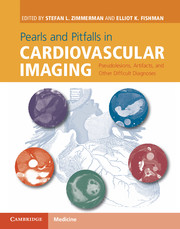 Pearls and Pitfalls in Cardiovascular Imaging
Pearls and Pitfalls in Cardiovascular Imaging from Section 2 - Cardiac aneurysms and diverticula
Published online by Cambridge University Press: 05 June 2015
Imaging description
Ventricular aneurysms are defined as focal regions of abnormal diastolic contour with systolic bulging. True left ventricular aneurysms are composed of all layers of the myocardial wall and are due to prior myocardial infarction and scarring (Figure 14.1). They most frequently occur in the LV anterior wall and apex in the LAD vascular territory. True aneurysms can be recognized by thin walls, wide neck, and dyskinetic motion on dynamic functional imaging. On late gadolinium enhancement cardiac MRI images, true aneurysms will have transmural enhancement due to post-infarct fibrosis (Figure 14.1). On CT, chronic aneurysms may calcify (Figure 14.2). Thrombus formation within true aneurysms is common and is important to recognize (Figures 14.1, 14.2). False aneurysms, or pseudoaneurysms, do not contain all layers of the myocardium and are equivalent to a contained rupture of the myocardial wall, usually due to prior infarction. False aneurysms have a narrow neck (Figure 14.3) and are dyskinetic on functional imaging. False aneurysms most often occur in the inferior wall in the right coronary artery vascular territory or in the lateral wall in circumflex territory.
Importance
True aneurysms have a high risk of thrombus formation due to blood stasis, which can lead to stroke or other systemic embolization. False aneurysms are important to recognize due to their instability and high risk of rupture, which occurs in 30–45% of cases. These aneurysms require prompt surgical treatment.
Typical clinical scenario
Left ventricular aneurysms usually occur in patients with prior myocardial infarction, and may be incidentally discovered at cross-sectional imaging performed for unrelated indications. False aneurysms can also be seen in the setting of prior surgery or trauma.
Differential diagnosis
Takotsubo, or stress cardiomyopathy, presents with symptoms identical to myocardial infarction and will show apical dyskinesia on functional imaging. However, Takotsubo cardiomyopathy is a transient abnormality and patients have no significant coronary artery disease. Ventricular diverticula can mimic aneurysms due to outward bulging in diastole; however, unlike aneurysms they contract during systole.
To save this book to your Kindle, first ensure [email protected] is added to your Approved Personal Document E-mail List under your Personal Document Settings on the Manage Your Content and Devices page of your Amazon account. Then enter the ‘name’ part of your Kindle email address below. Find out more about saving to your Kindle.
Note you can select to save to either the @free.kindle.com or @kindle.com variations. ‘@free.kindle.com’ emails are free but can only be saved to your device when it is connected to wi-fi. ‘@kindle.com’ emails can be delivered even when you are not connected to wi-fi, but note that service fees apply.
Find out more about the Kindle Personal Document Service.
To save content items to your account, please confirm that you agree to abide by our usage policies. If this is the first time you use this feature, you will be asked to authorise Cambridge Core to connect with your account. Find out more about saving content to Dropbox.
To save content items to your account, please confirm that you agree to abide by our usage policies. If this is the first time you use this feature, you will be asked to authorise Cambridge Core to connect with your account. Find out more about saving content to Google Drive.